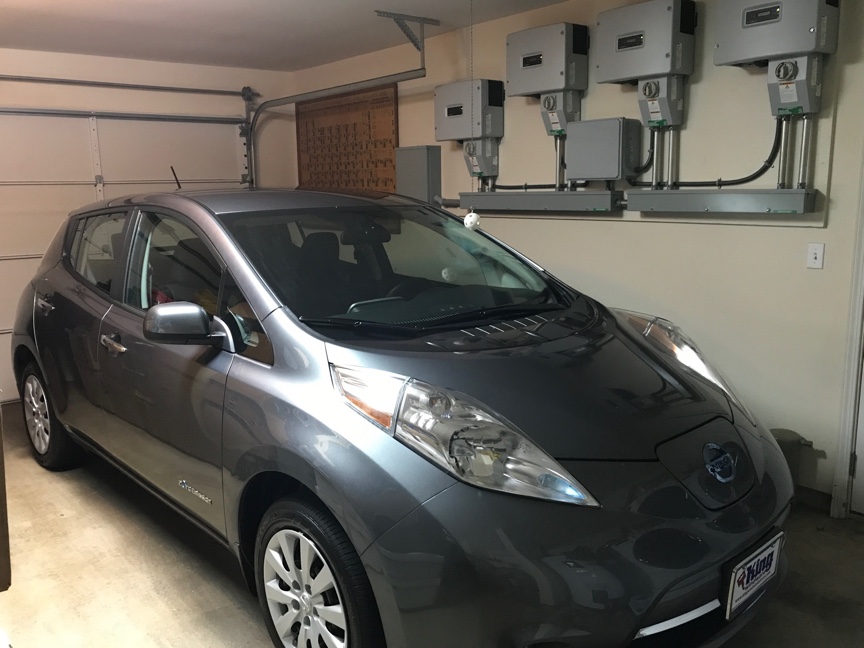
Home - General: Getting Used to an EV
As an electric-vehicle (EV) owner, I'm an odd combination of a newbie and an "old-bie". I first rented and test-drove an EV, a General Motors EV1, in 1998, and before that I first became interested in EVs when the GM Impact (the prototype for the EV1) was rolled out at the Los Angeles Auto Show in 1990, so I go back almost thirty years with EVs. However, though I owned natural-gas-powered vehicles from 1993 to 2007, and an electric moped from 2003 to 2007, in all those years I never owned a four-wheeled electric vehicle!

That changed on Earth Day, April 22, 2017, when my family bought a 2017 Nissan LEAF from King Windward Nissan in Kaneohe on the island of Oahu in Hawaii. I thought that, now that I have some months of practical experience (rather than just a few overnight rentals), I could offer some useful observations to other new EV owners, or to those considering buying an EV. I knew all this stuff in theory before, but as Yogi Berra is said to have said, "in theory, there is no difference between theory and practice; in practice, there is." I hope that this webpage, like my other one about our photovoltaic system (whose inverters are visible in our garage behind the LEAF in the photo above), will provide some useful real-world information to new and potential owners. It is not a review of the LEAF in particular; I will try to make it general enough to be of benefit to those considering, or starting out with, any vehicle with a plug.
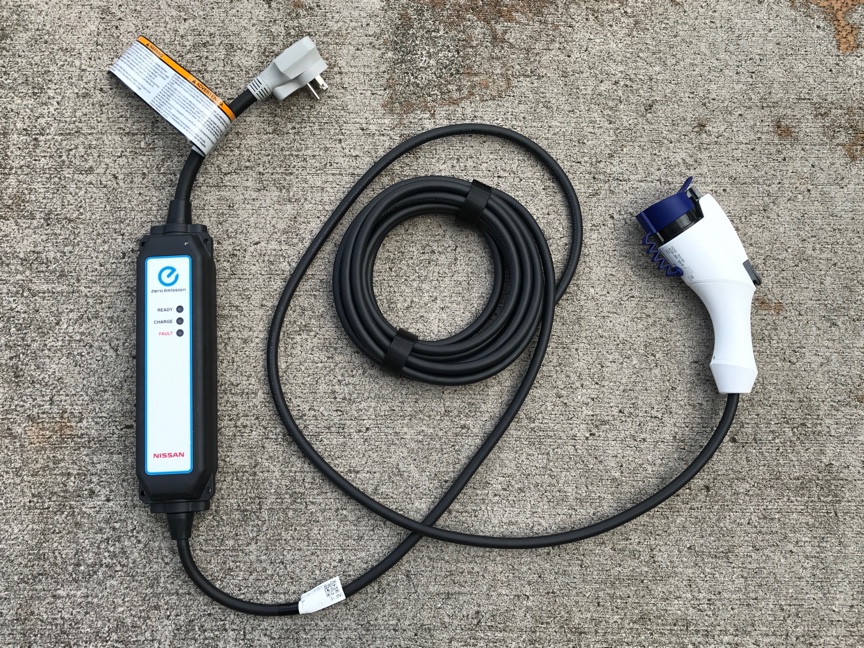
Of course, the biggest difference between an EV and a gasoline vehicle is that you plug an EV in to recharge it, rather than taking it to a gas pump to refuel it. There are also plug-in hybrid electric vehicles (PHEVs), which are able to carry enough energy from plugging in to do most of their driving but which can also supplement it with gasoline to drive longer distances; the LEAF is a plug-only EV. In the day of the EV1, an obstacle to broader adoption of EVs was the lack of standardization in charging hardware: any gasoline vehicle can fill up at any pump, but twenty years ago there were competing, incompatible standards for connectors to recharge EVs. That has, for the most part, been ironed out, so that all modern EVs and PHEVs in the United States can use a connector like the one on the right end of the apparatus in the picture above, which came with our LEAF. (Tesla vehicles have an incompatible, proprietary charge port, but they come with an adapter to use this kind as well.) The connector has the mellifluous name of "J1772," after the SAE (Society of Automotive Engineers) standard that defines its specifications.
Besides the connector, charging hardware (broadly referred to as "Electric Vehicle Supply Equipment" or EVSE) is specified by how it obtains electrical energy and how fast it can transfer it to the vehicle. The rig pictured above plugs into a standard 110V wall outlet, and puts energy into the vehicle's battery at the slow, "Level 1" rate of about 1.5 kW (kilowatts). Thus you can carry this in the vehicle, and in a pinch you can "refuel" from any household electrical outlet that can handle a hair dryer, say one with a 20A circuit breaker (if there are no other comparable loads on the circuit at the same time). Level 1 charging is pretty slow, though; a battery pack's energy capacity is specified in kilowatt-hours (kWh), and just like any other electrical load (say, a house) a kilowatt of power transferred for an hour adds up to a kilowatt-hour of energy. The battery pack of our LEAF holds 30 kWh, so you can see it would take about twenty hours plugged in to take it from empty to full at the Level 1 charging rate! That seems unreasonably long at first glance; however, most people won't empty even a 30 kWh pack (which is modest by modern standards) in a day's driving, and the recharging can be done in your garage while you sleep rather than while you wait at a refueling station. Thus, depending on your driving cycle, you may never need to charge faster than Level 1; except for one day out of eight months so far we haven't, as I'll discuss below under "Range."
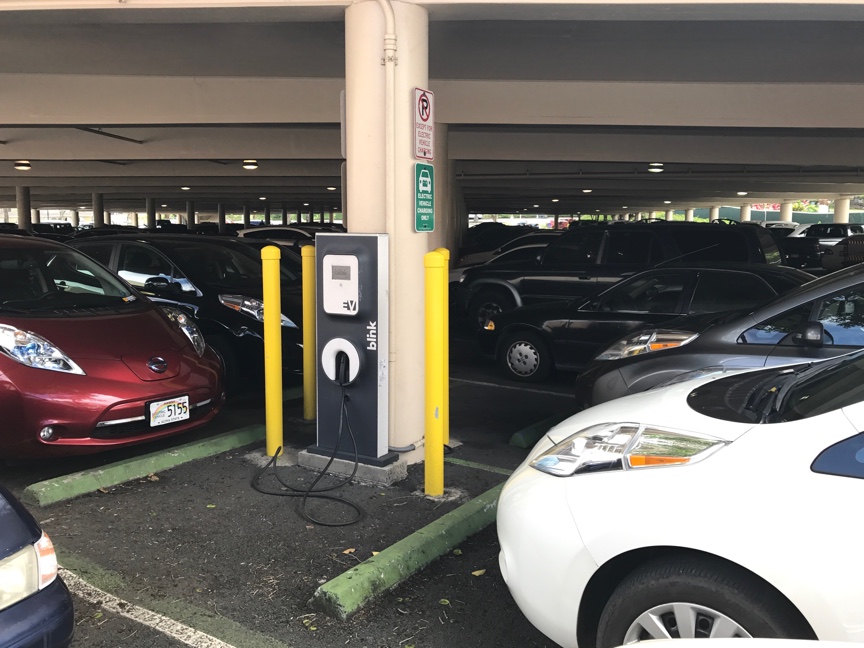
However, you certainly can do so if you need or want to. This is a typical public EV charging station, with four LEAFs parked around its two EVSE boxes. (Note that none are plugged in; sometimes EV drivers just go for the primo parking spaces, as here at a mall, even if they don't need the juice. Enforcement of "EV parking only while charging" signage may or may not be vigilant.) The cable plugs into the vehicle with the same J1772 connector as in the Level 1 apparatus above; however, public chargers typically run at Level 2, transferring power at up to 6.6 kW. That's over four times as fast as Level 1, so that you can recharge a substantial fraction of a vehicle's battery capacity in a typical stay of a few hours at a mall, say.
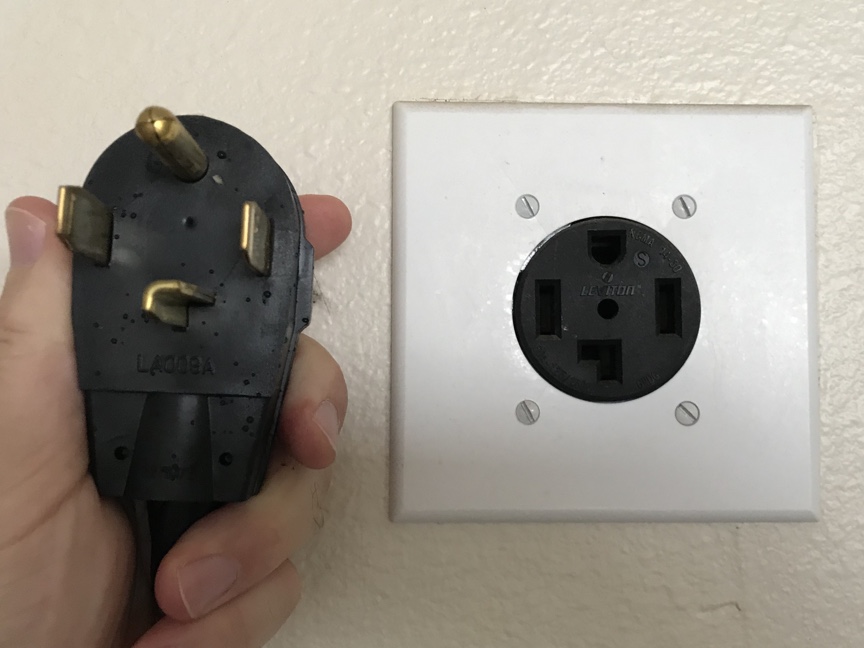
You can also charge at home at Level 2 speeds, using the same 240V circuitry that would power an electric clothes dryer (with about a 40A circuit breaker). You can buy Level 2 EVSE that you (or an electrician) would hard-wire into such a circuit in your garage (in some places you can even get such a unit for free as an incentive to drive an EV -- ask your EV dealer), or you can get a unit with a cable attached that plugs into a dryer socket. This would typically use the "NEMA 14-30" connection shown here, another name derived from an industry standard, in this case one from the National Electrical Manufacturers Association. These connections can be a lot stiffer than ordinary household 110V plugs, so you probably wouldn't want to unplug your dryer and plug in your EVSE every time you needed a charge! It would be better to have a dedicated outlet installed for the Level 2 charger and just leave it connected, unless you decided to take it to Grandma's house for an extended visit or something. If it would be on the same circuit as a dryer, though, running them both at once would pull too much current and trip the breaker, so an A/B switch would have to be installed to toggle between the two outlets so only one could be used at a time.
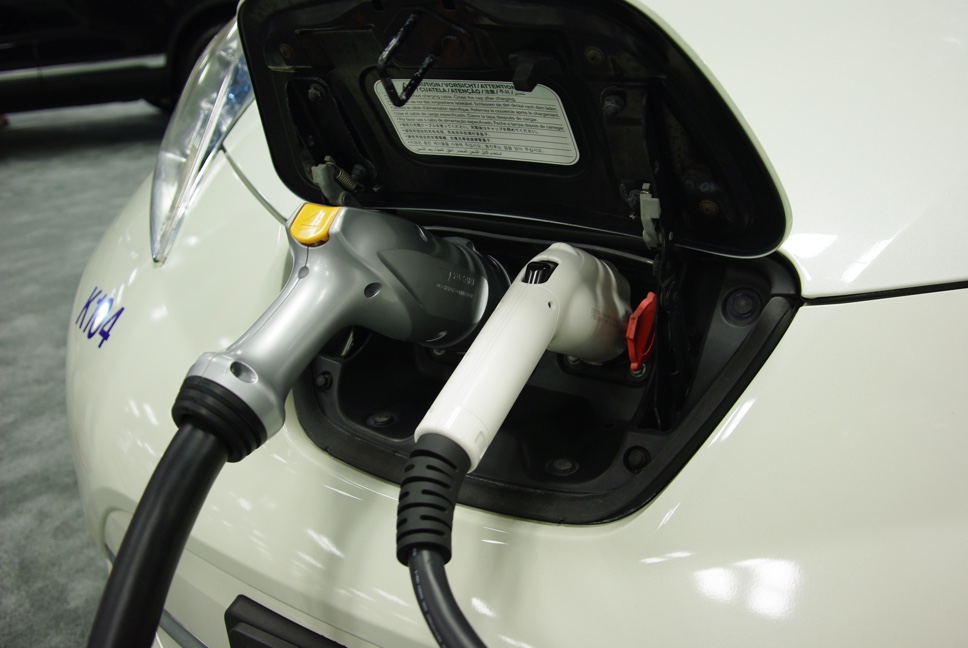
Essentially every modern EV or PHEV can charge at Level 2 speeds (some of the earliest LEAFs were limited to half the 6.6 kW Level 2 power), but many can charge at even faster Level 3 speeds, transferring dozens or potentially hundreds of kilowatts of power for a very quick fill. Here the standardization breaks down, though. The LEAF uses a quick-charging standard called CHAdeMO, with a connector (shown above) that looks like a bigger version of the J1772 connector and needs a second inlet in the car. Some other vehicles use the Combined Charging System (CCS) that adds more electrical contacts to a J1772 connection so that the Level 3 inlet is an extension of the Level 2 inlet on the vehicle (the same way that a USB 3 socket on a hard drive is an extension of the USB 2 version, so that you can also plug a USB 2 cable into it). And again, Tesla has their own "Supercharger" standard. (Of course, you wouldn't plug two EVSE cables into a vehicle at once; I took this photo on the floor of the 2017 Honolulu Auto Show, where both unpowered connectors were plugged in to a LEAF to showcase the dual charging-speed capability.) The Chargeway project is trying to make this easier to keep track of with a system of colors (for connector standard) and numbers (for charging speed), but until that or something similar takes hold, you should talk to your dealer about whether your vehicle can handle Level 3 charging, and if so what kind of connector you'll need to look for. And again, any modern plug-in vehicle can charge at any public Level 2 station that you'll run across.
Level 1 and Level 2 chargers transfer 110V or 240V alternating current (A/C) electricity to the vehicle, while Level 3 EVSE runs on industrial 440V A/C power but transfers direct current (D/C) to the vehicle (for this reason it's also sometimes called "DCFC" for direct current fast charging). I have heard of one rich enthusiast who had such a rig (and the dedicated transformer and circuitry to power it!) installed at home, but while that's possible it's not remotely a practical idea, and you'll normally see Level 3 only at public facilities. A good use would be at a highway rest area, so your vehicle could take onboard a good amount of energy while you stop during a road trip for long enough to get coffee and use the restroom, rather than the few-hour stay for Level 2 charging at a mall that I mentioned above.
You will have noted that throughout this discussion I refer to charging your EV while it's parked in your garage at night; of course, if you live in an apartment or condo where you don't have control over whatever electrical circuits are available near your parking space, or if you have to park on the street, that isn't an option. If you can plug in your vehicle at work, well, that's a good several hours of (typically Level 2) charging too, but in general it is going to be necessary to reduce the cost, boost the speed, and increase the availability of public Level 3 (or faster) charging before EVs can really be practical for people who can't plug in while they sleep. They will need to be able to recharge during the day with something close to the speed and convenience with which they can now refill a gas tank. For the present, therefore, I'm only addressing potential EV drivers who can charge up at home. (I do know of one EV1 driver twenty years ago who lived in an apartment and relied on the public Level 2 EVSE infrastructure in Santa Monica, but he was the earliest of "early adopters".)
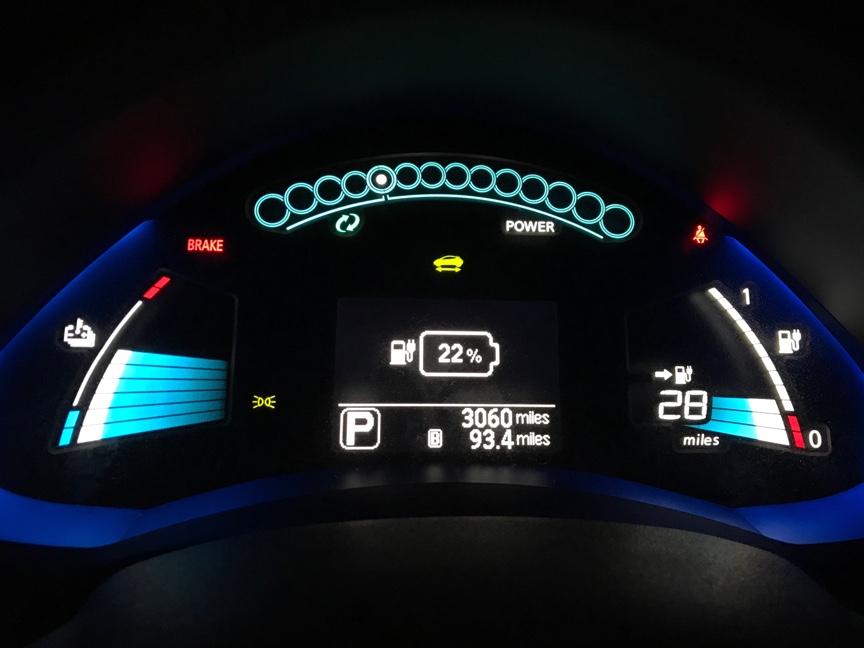
With a PHEV, you really don't have to concern yourself with how much electricity you are using from the battery pack, unless you are trying to maximize efficiency; just plug in whenever it's convenient, and if you run out of battery charge you can keep going on the contents of the vehicle's gasoline tank. Because a battery-only EV like our LEAF can only reload energy at home or the occasional public charger, though, it makes sense to pay some attention to how your charging habits interact with your driving habits. The key is to think about how much you drive in a day, rather than in a week or two or however long it takes you to empty the tank of a gasoline vehicle: it'd be a hassle to go to a gas station every day, but since you can plug in an EV while you sleep there's no inconvenience associated with "refueling" your EV every day.
Many modern gasoline vehicles provide an indication of how many miles you can go, with your present fuel usage averaged over some period of time (typically a couple of hours, I think), before you need to refuel; every EV will give you this information! In the case of our 2017 LEAF, the remaining range is indicated at the location showing "28 miles" inset into the bars of the "fuel level" gauge at right in the photo above. The EPA provides an official estimate of the range of the vehicle on a full charge under standard test conditions, but your driving style, traffic, and terrain will probably not be "standard." As it learns your typical use, the vehicle's estimate of remaining range when it is fully charged will become more accurate, but if you want to keep an eye on it during the day, to see if you are using more or less energy than the vehicle estimates, use the trip odometer.
If you zero it when the vehicle is fully charged, then as you drive the sum of the trip odometer reading and the estimate of the remaining range will be an updated estimate of the total range per full charge. I took this photo after the longest full day's driving on a single charge that we've done so far; you can see that the battery charge is down to 22% (your vehicle may also provide this kind of numerical indication in addition to a graphical "fuel gauge"). The sum of 93.4 miles driven plus 28 miles remaining, or 121 miles, is actually higher than usual for us; a lot of the driving that day was on flat roads along the south of the island out to Ko Olina and back, rather than our typical commute. For our usual driving, the car's computer is smart enough that the sum usually stays right around 110-115 miles, slightly more than the EPA rating for the vehicle of 107 miles. (From this and the 30 kWh capacity of the battery pack, you can calculate that the LEAF goes between 3 and 4 miles on a kWh of electrical energy, which is typical of a modern, modest-sized EV like this.)
Again, though, this is the longest day's driving we've done on a single charge; more typical is a 24-mile round-trip commute for my wife over the Ko'olau pass at 1000' elevation. We are on pace to put over 10,000 miles on the vehicle in its first year, which is pretty typical of American drivers; and yet there is literally only once in eight months so far when we've needed to use Level 2 charging to top off for a couple of hours (I drove to Ko Olina and back twice that day). We haven't bothered to put Level 2 charging EVSE in our garage, but just using the Level 1 apparatus pictured near the top of this page, the car is almost always fully recharged after a night of being plugged in. If it was an unusually long driving day, then a second night's charge (after the next day's more typical driving) is enough to bring it up to full. 110 miles per charge sounds scarily short if you're used to getting 300 miles or so on a tank of gas; but again, if you can plug the vehicle in while you sleep, you only need enough electricity for one day, not enough gas for two weeks. And you'll never need to sit in line at a gas station during rush hour!
That said, a couple of things that will affect your range are the air conditioner and regenerative braking. I have found that, for our typical commuting use, the air conditioner knocks the range per charge down by several percent; if you live in a hotter climate or spend more time sitting in traffic, of course, it will use proportionately more, but the car will learn to factor that into its range estimate. Regenerative braking is one of the advantages of any vehicle that uses electricity, including a non-plug-in hybrid, whereby the electric motor "runs in reverse" as a generator to slow the vehicle by converting energy of motion into electricity that's put back into the battery pack. Again, a modern EV (or PHEV) will typically have an indicator of the regenerative braking; our LEAF shows it on the arc of circles labeled "POWER" at the top of the gauge cluster. When the vehicle is sitting, only the one white circle shown is filled, and as you accelerate or climb a hill the circles to the right fill in to show how much power you are drawing from the batteries. Conversely, when you slow down or descend a hill, the circles to the left fill in, in green (notice the "recycling" arrows below that part of the gauge), to indicate the amount of power being recovered by regenerative braking.
The first time I drove an EV, in 1998, I thought that regenerative braking only occurred during "coast down," when the vehicle slows without the brake being applied; the EV1 I had rented did not have a gauge like this, so there was no indication otherwise. However, I subsequently learned that modern EVs (and PHEVs, and non-plug-in hybrids) have what is sometimes called "blended regenerative braking," whereby the computer notes how hard you are pressing the brake pedal (and how full the battery is) and balances regenerative and friction braking to maximize the amount of energy that goes back into the battery instead of being wasted as heat in the brake linings. Thus there's no need to keep your foot off the brake pedal and coast to a stop in order to gain the benefits of regenerative braking. On the whole, though, as with a gasoline vehicle, "jackrabbit starts" and hard stops waste energy, though an EV wastes less.
By the way, like most vehicles with regenerative braking, the LEAF has a "B" position on the shifter that increases the strength of regenerative braking compared to "D". This acts like engine braking in a gasoline vehicle with its automatic transmission set to "L" or "overdrive lockout" to slow it as it descends a hill. I have found that this is too powerful for any of the roads I've driven on Oahu; even on the fast, steep downslope of the H-3 heading south, "B" slows the LEAF down rather than just making it easier to maintain speed without riding the brake pedal. "Your mileage may vary," as they say.
The final thing I'd like to bring to your attention in the photo of the gauge cluster above is the battery pack temperature indicator at left. I'm old enough to remember NiMH and lead-acid batteries, in laptops or in EVs, for which you had to be careful of the charge level, not letting them sit empty nor overfilling them lest you do permanent damage. I asked an officer of the Electric Automobile Association, who really oughta know, if this was the case for modern lithium-ion batteries, and he told me that the only thing to worry about for them is temperature. Running in a hot climate, and/or moving lots of power into or out of them too often by flooring the accelerator or using Level 3 charging routinely, will cause them to lose capacity faster than they otherwise would. So it's a good idea to keep an eye on this gauge if any of that applies to you; I will say, though, that in eight months I have literally never seen the temperature gauge move off the midpoint where you see it here. Again, we're in the warm-not-hot climate of Hawaii, we almost never charge faster than Level 1, and most of the roads aren't very steep nor the speed limits very high here; so our LEAF has cushy duty. Still, though, it's good to see that the cooling system is (more than) up to the task of keeping the battery pack healthy.
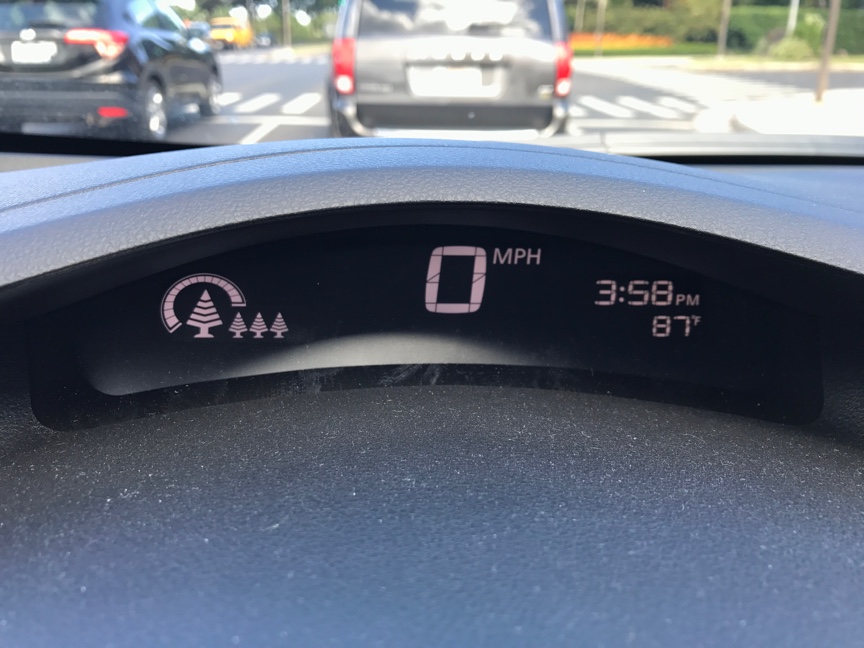
Your EV or PHEV will have any number of other controls, indicators, etc.; the ones discussed above, as is perhaps clear from their placement at the center of the instrument cluster, are among the most important. Other options, which I have not found the need to explore yet on our LEAF, include the ability to tell the vehicle to wait after plugging in for some time before beginning to charge the batteries so that you can use cheaper time-of-use utility rates, or the ability to start the climate control at a particular time so the interior will be comfortable when you come out to drive away. One thing I've seen in a number of vehicles, starting with the first-generation Toyota Prius, is an indicator of how "green"-ly you are driving. Our LEAF provides a cute li'l tree next to the speedometer; as you drive, it builds up from the base in five segments, more quickly if you are driving conservatively. After a tree is complete, it moves off into the "forest" to the right and a new one starts growing; four trees here is a fairly long drive, driven with a light foot. Your vehicle may have a quantitative graph like the Prius or a qualitative indicator like this, but it will probably have some way to give you feedback on your driving.

Your EV may also have the option for remote monitoring of various of its functions (our base-trim 2017 LEAF "S" does not); notably, it may be able to tell an app on your phone when the battery is fully charged if you are waiting for that while you shop or something. I saw this sticker on the windows of a Tesla Model S, which can tell you remotely when the interior temperature is comfortable; that little dog wouldn't overheat under clouds and rain like this, but the owner made sure nobody felt the need to "rescue" him from the car on a sunny day!
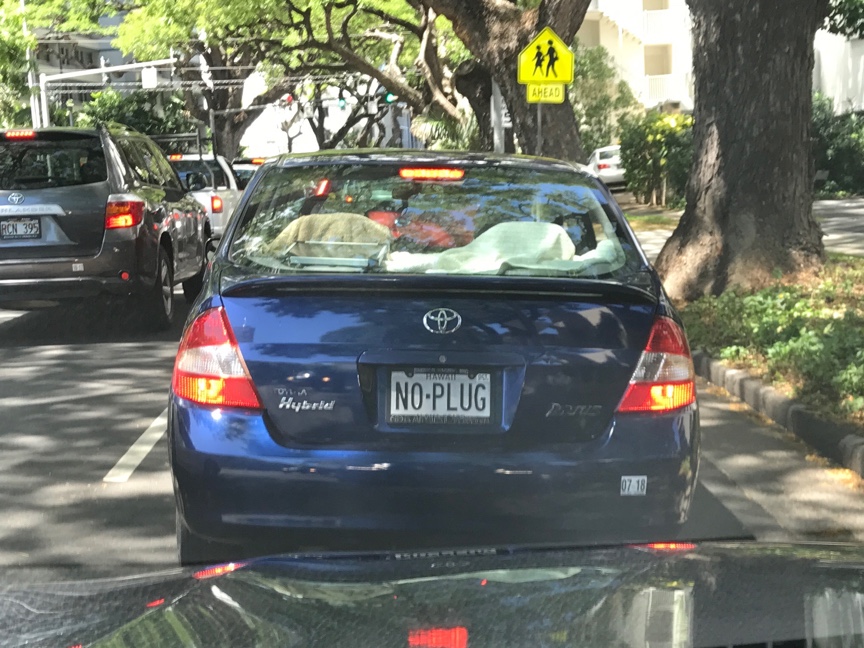
Let me leave you with this photo of an old (first-generation) Prius, with license plate NO-PLUG. Back when the first hybrids became available, automakers took great pains to explain to potential buyers that you drive them like ordinary gasoline cars, just more efficiently; in particular, "you don't have to plug it in" like an EV (which had appeared on the roads in small numbers just a couple of years earlier). This driver apparently adopted that as a boast; even back then EV advocates said that it was more of a limitation -- "you can't plug it in" -- and these days it seems that, at last, more and more people are agreeing with us. As I write this I just returned from a trip on which I took a detour to visit the Los Angeles Auto Show and ... wow. Of course, some automakers are still fighting a rear-guard action to discourage people from trading in their non-plug-in hybrids for EVs as we did; but the mindshare is more and more against them. I think that if you decide to go the plug-in route you'll find out that, like more and more drivers in the United States and around the world, you made the right choice!
 Back
to Fueling Station
Back
to Fueling Station Site
Map
Site
Map Contact
Me
Contact
Me All content copyright 1998-2024 by Mark Looper, except as noted. Reuse of my copyrighted material is authorized under Creative Commons Attribution 4.0 International license (CC BY 4.0).
![]()
![]()
new 21 December 2017